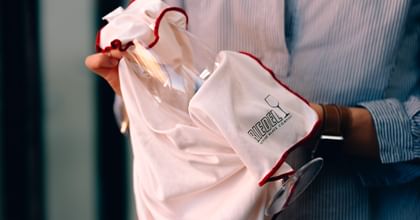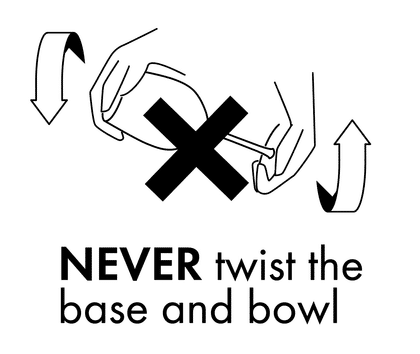How to clean your glasses
Glasses shall always be cleaned carefully.
Most RIEDEL glasses are dishwasher-safe, and under good operating conditions can withstand 1000 wash cycles without any demonstrable loss of shine or clarity. The dishwasher resistance has been tested in accordance with EN 12875-1:2005 and EN 12875-2:2001.
RIEDEL glasses labelled "hand wash only" or "not dishwasher safe" or supplied in packaging that does not show or contain care/cleaning instructions are not dishwasher safe and require handwashing.
What to consider when loading the Dishwasher:
- When loading glasses into the dishwasher, make sure that there is enough space between the glasses so that they do not touch each other or other objects.
- If possible, place your glasses on the top shelf of the dishwasher and use the glass holder if your dishwasher has one. This holder is designed to secure your glasses so that they do not slip during the washing process. When loading, make sure that the glasses do not touch any other objects, such as metal utensils or cups. Place your glasses in a way that they do not come into contact with other racks or the spray arms.
- Certain RIEDEL glasses may be too high to fit in the top rack of the dishwasher. If your dishwasher has a special glassware program, you can carefully place such glasses in the bottom rack, following the instructions above. Otherwise, they should be cleaned by hand.
- If available, you should use the stem holder in the dishwasher as such holder supports the glasses and prevents them from shifting.
- To avoid scratches: Avoid contact of glass with other glass or metal.
Setting the Dishwasher:
- Dosage: Dose the detergent and rinse aid according to the instructions; do not overdose. Please ensure that your dishwasher is always sufficiently filled with rinse aid.
- Water softening: Extremely soft water attacks the glass. The dishwasher's water softening system shall therefore be matched to the hardness of your household water and should correspond to a value of approx. 3-4 degrees German hardness (°dH). Please ensure that your dishwasher is always sufficiently filled with dishwasher salt.
- Temperature and program selection: When washing glassware you should select a low temperature program (50-55 °C) or, if available, a special glass program.
- Steam: After washing, it is important to open the dishwasher door (if this does not happen automatically anyway) to allow moisture to evaporate, as water steam can attack the glass surface and increase glass corrosion.
- Food residues and fruit juices: Large quantities of food residues and/or fruit acids, such as those contained in juices, can affect the composition of the rinsing liquid and therefore the quality of the rinsing process. It is therefore advisable to pre-rinse such soiled items by hand.
- The joint washing of glass and aluminum household utensils (e.g. garlic press, pots with aluminum handles, etc.) shall be avoided by all means, as this leads to chemical reactions between the aluminum and the glass surface, which inevitably lead to glass corrosion within a very short time.
Hand Washing and Hand drying/polishing:
- If you wash your glass by hand, clean it carefully under warm water (use washing liquid and rinse the glass gently). Please ensure that you do not use excessively hot or boiling water for rinsing.
- To avoid detergent residues, rinse the glasses thoroughly with clear water.
- Use two large microfiber drying cloths to dry and polish the glass.
- Never hold the base plate and the bowl at the same time when drying or polishing the glass, as this can cause the stem to break due to twisting.
- To polish the bowl, first hold the glass with a drying cloth directly under the bowl with one hand or place the bowl in one hand and carefully polish the inside and outside of the bowl with the other hand using the second drying cloth.
- To polish the base plate, hold it firmly with one hand and polish it carefully with the other hand.
- Avoid drying your glasses upside down on a metal rack, as this could damage the rim.
- Do not use a tea towel for drying or polishing as this could damage your glass, instead use two microfiber polishing cloths.
- We recommend using RIEDEL microfiber polishing cloths, which dry easily and polish lint-free when washed correctly (see below).
- Wash polishing cloths at a high temperature of 60°C/140°F (to kill bacteria) with odorless soap.
- Do not use fabric softener when washing your microfiber polishing cloths (to avoid a greasy film on the glass surface).
- Attention: Microfiber polishing cloths shall not be put in the tumble dryer.
Storage:
Avoid storing glasses in kitchen cupboards next to strong smelling items, as the glass can absorb this odor, which can affect the aroma of the wine.
Preventing Glass Clouding:
Glass is a material that delights the observer with its shine and clarity. However, these characteristics trigger the visibility of glass surface damages, even if it is only minimal. For example, a permanent clouding of a glass is already clearly visible, if the glass is affected at a depth that is a thousand times thinner than 1 mm. In principle, all glasses are subject to this optical change process over time. The cause of the clouding is often difficult to trace, however, surface damages can be counteracted by machine rinsing.
The clouding of glassware in the dishwasher can have two different causes.
In many cases, the clouding is due to deposits of limescale or detergent residues. These can be easily removed with mild acids (e.g. citric acid or white vinegar).
The situation is different with glass corrosion, where components are washed out of the glass and the structure of the glass changes, which appears as a white coating on the glass. Unfortunately, it is not possible to reverse or repair glass corrosion.
In addition to the recommendations for washing glassware in the dishwasher or by hand, you should always make sure to rinse the glasses immediately after use so that no beverage/wine residue can build up. Red wine is particularly powerful as the acidity will attack the glass if residues remain too long.
How to Clean Your Decanter
Decanters shall always be cleaned carefully.
Most RIEDEL decanters shall only be cleaned by hand, unless other care/cleaning instructions are expressly stated on the respective product detail pages of our website. A list of all decanters can be found on our website in our product overview with detailed information on the respective product detail pages. If your decanter is not listed, please contact our customer service team.
Rinse the decanter with clear water immediately after use to ensure that no wine residue remains in the decanter. Red wine is particularly powerful and the acidity can attack the surface of the decanter if the residue remains in the decanter for too long. Then fill the decanter with warm water and let it stand overnight. The next day, remove the water and then fill the decanter with about ½ liter of distilled water. Swirl the decanter with the distilled water in it and then pour it out again. Water and citric acid or vinegar essence can also be used to clean the decanter, then rinse well to avoid odors.
Then leave the decanter to dry and polish the outside with a microfiber polishing cloth.
Make sure that you do not hit the tap with the spout of your decanter, as this can lead to chipping. If your decanter is too high for your sink, you can also rinse it in the bathtub or shower.
Avoid using washing liquid or soap to clean your decanter, as it can be very difficult to remove all residues completely.
For stubborn stains, you can also try special cleaning tabs for glassware.
Cleaning beads can help to remove stubborn stains inside the decanter. Simply fill the decanter with warm water, slowly and carefully pour the cleaning beads into the decanter through a funnel and swirl the pearls around for about two minutes. Then carefully pour off the pearls using a sieve insert, rinse, dry and store for later use.
ATTENTION! Please note that cleaning beads and our RIEDEL decanter cleaners (=cleaning beads) shall not be used for the following decanters, as they could get stuck or damage the decanter due to the respective decanter shape: Ayam, Amadeo, Eve, Escargot, Curly, Boa, Black Tie, Mamba, Horse, Horn, Tyrol, RIEDEL Winewings, Swan and Face to Face. Please also note that this listing only includes decanters from the current range. You can find a list of all decanters on our website in our product overview with detailed information on the respective product detail pages. If your decanter is not listed, please contact our customer service team.
NOTE: More cleaning recommendations by Maximilian J. Riedel at https://www.youtube.com/watch?v=WyjKRcwvE08 and https://www.youtube.com/watch?v=SKSQ8K1d9lY.

